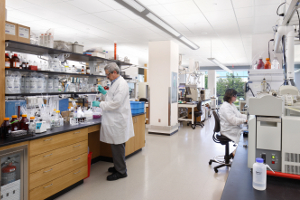What is environmental health testing?
The Environmental Health Program performs diverse sample testing of everything from air to wastewater, including clinical specimens (blood, hair, teeth, urine, etc.), fish, foods (spinach, orange juice, etc.), soil and sediment, water (drinking water, groundwater, wastewater, and surface water, and the unusual (athletic shoes, beehives, mail, various unknown powders, etc.). These samples may be analyzed for analytes literally from A – Aatrex (atrazine) to Z – zirconium. For the most part, these samples are analyzed for a set list of analytes in support of an existing regulation, contract, grant or monitoring program.
In the Ankeny laboratory, testing services include industrial hygiene, limnology, metals, microbiology, minerals, nutrient demand, blood and environmental lead, and emergency preparedness testing as needed. In the Coralville laboratory, testing services include, asbestos, radionuclides and volatile organic compounds such as gasoline, polychlorinated biphenyls (PCBs), insecticides, herbicides and other pesticides, as well as emergency preparedness testing as needed.
Both Environmental Health Laboratories are actively involved in all-hazard preparedness as part of the CDC Laboratory Response Network (LRN), FDA Food Emergency Response Network (FERN) and both EPA’s Environmental Response Laboratory Network (ERLN) and Water Laboratory Alliance (WLA).



